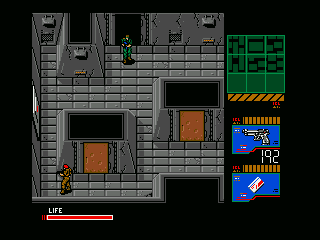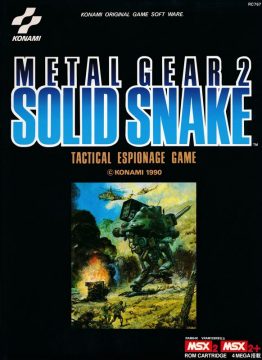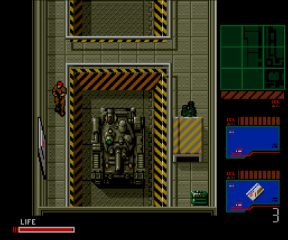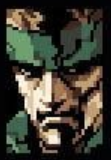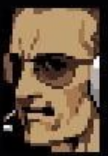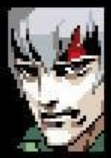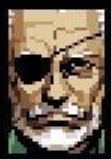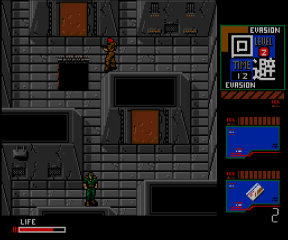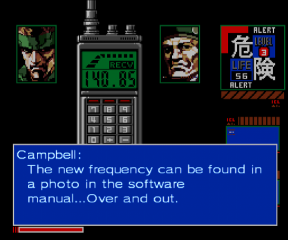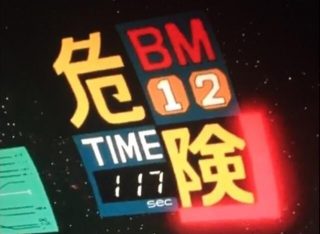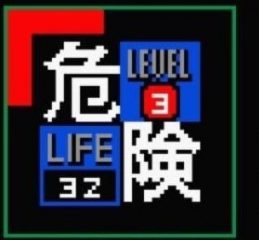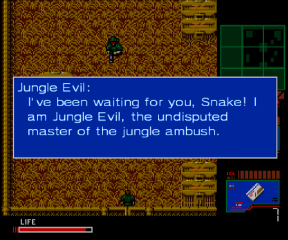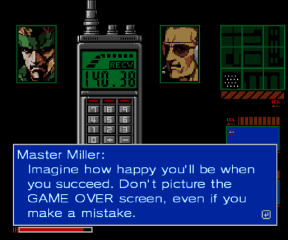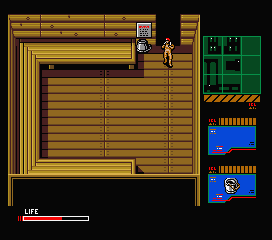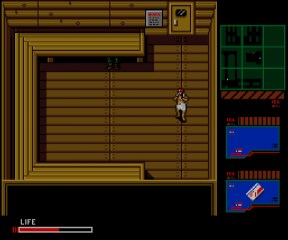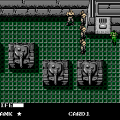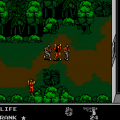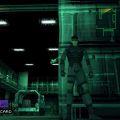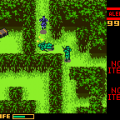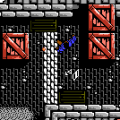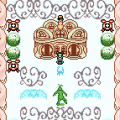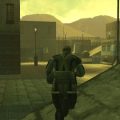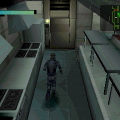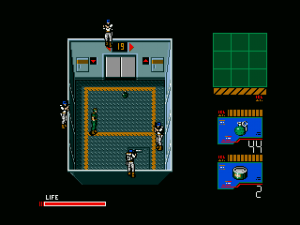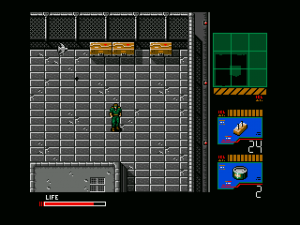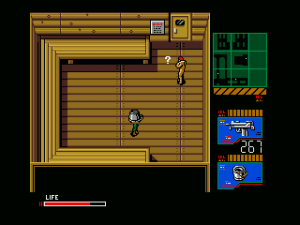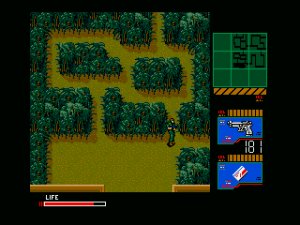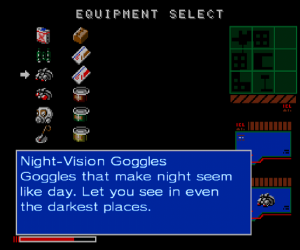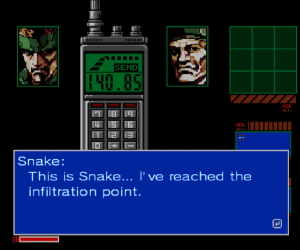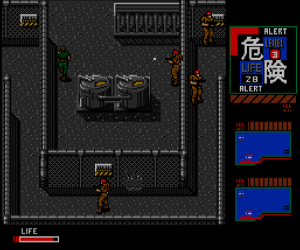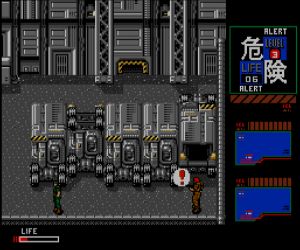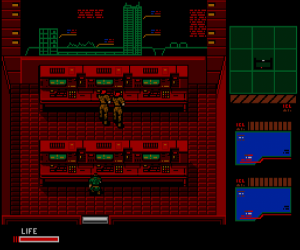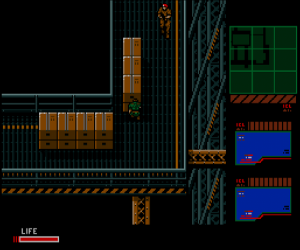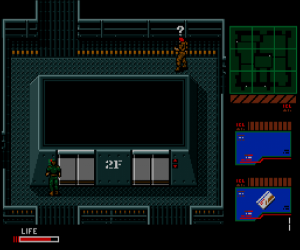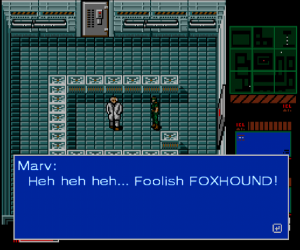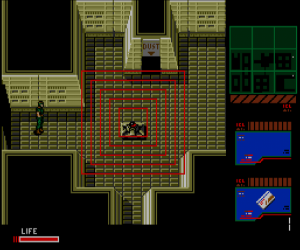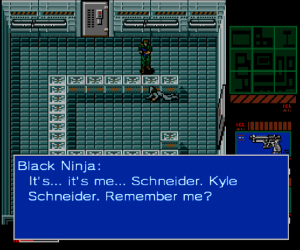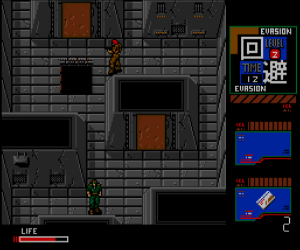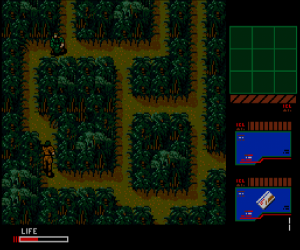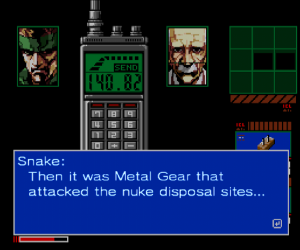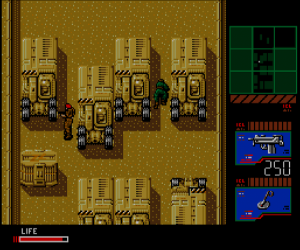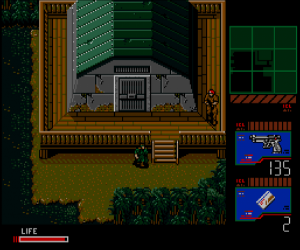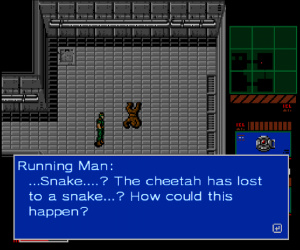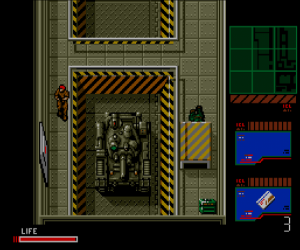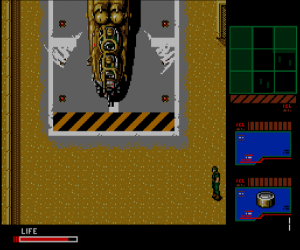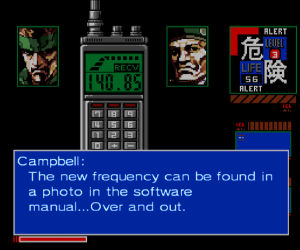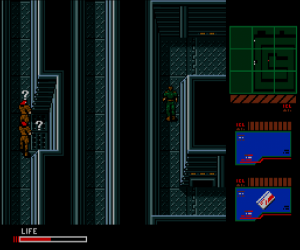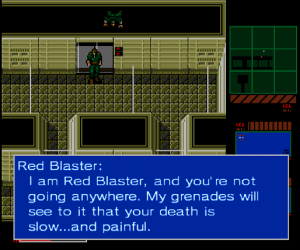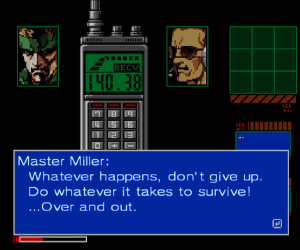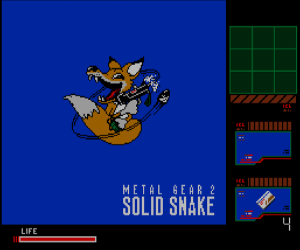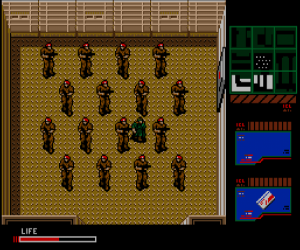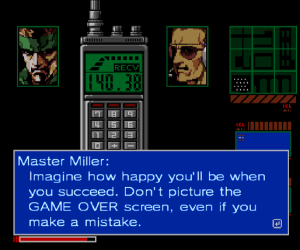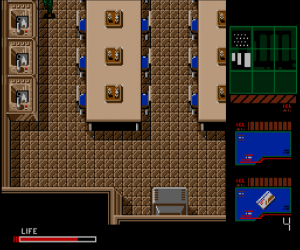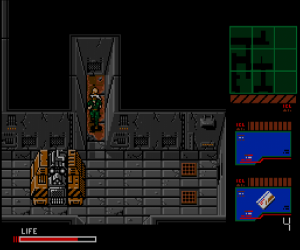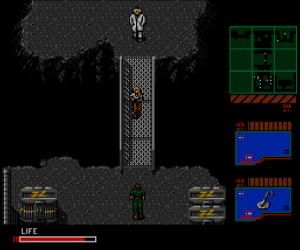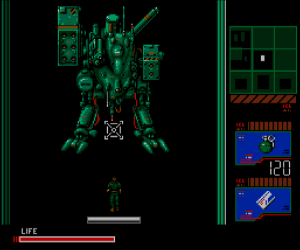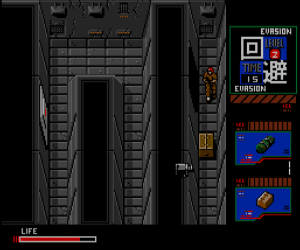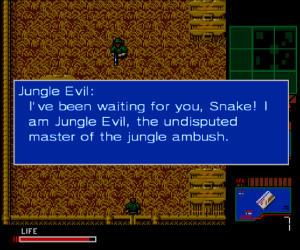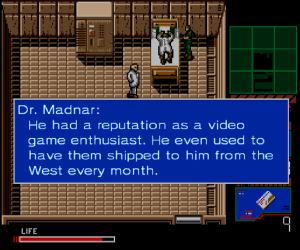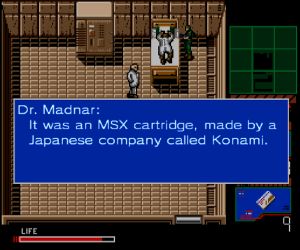- Metal Gear
- Snake’s Revenge
- Metal Gear 2: Solid Snake
- Metal Gear Solid
- Metal Gear Solid Integral Staff Commentary
- Metal Gear Solid (Game Boy Color)
- Metal Gear Solid 2: Sons of Liberty
- Document of Metal Gear Solid 2, The
- Metal Gear Solid: The Twin Snakes
- Metal Gear Solid 3: Snake Eater
- Metal Gear Solid 4: Guns of the Patriots
- Metal Gear Solid: Portable Ops
- Metal Gear Solid: Peace Walker
- Metal Gear Solid V: Ground Zeroes
- Metal Gear Solid V: The Phantom Pain
- Metal Gear Rising: Revengeance
- Metal Gear Touch
- Metal Gear Acid
- Metal Gear Acid 2
- Metal Gear Solid Mobile
Metal Gear was a hit in Japan, and its NES port reached international players in Europe and North America, but the people behind it hadn’t heard much of that success. They turned their attentions to cyberpunk and detective work with the ambitious visual novel adventure, Snatcher. It wasn’t until a chance encounter with a fellow Konami employee in the Famicom division on the train ride home that Hideo Kojima learned of a sequel being done without his team’s involvement, titled Snake’s Revenge. His colleague encouraged the director to make something more official, from the original source. By the end of the ride, Kojima had a story in mind, one drawing on the Cold War, nuclear proliferation, and humans’ dependency on fossil fuels. After a conversation with higher ups the next day, work began on Metal Gear 2: Solid Snake. While it was eventually released in July 1990 on the MSX2, the game took the rough draft found in Metal Gear and improved on it in just about every way.
The serendipitous way that the game’s development started isn’t the only unique nugget of its creation. Despite the 8-bit machine it was destined to run on, the team sought authenticity in their tactical espionage game. Reference material from films & comic books were used to design the game’s weapons. The team staged survival games in the mountains, trying to immerse themselves in the field of battle. Some people even started to show up to work in full soldier fatigues. Some of the photographs of their exploits and the developers’ personal equipment made it into the manual, in parts that detailed the story and setting. The team paused, part way through development, in order to help finish work on SD Snatcher, funnily enough.
In an alternate 1999, the world is just beginning to start to come out of the Cold War, and talks are being held over the disarmament and disposal of nuclear weapons. At the same time, a sudden oil crisis sparks a new biological innovations from a Czech scientist, Dr. Kio Marv. He develops OILEX, an engineered algae that can create oil from virtually nothing. And if that wasn’t enough, Zanzibar Land, a rogue mercenary state newly formed between the USSR and China, inserts itself into both situations. They kidnap Dr. Marv, and steal nuclear warheads meant for disposal, in an effort to take the world hostage. Solid Snake once more dons on his cardboard box to avert global disaster. As he moves forward with his mission, he comes to realize that his past with FOXHOUND intertwines with this mission in unexpected and deadly ways, including the development of a new model of Metal Gear.
The characters in Metal Gear 2 are much better realized than the original game. Instead of being limited to the radio transceiver screen and just barking order & info at the player & Snake, it becomes a conversation. And dialogue happens during the game, a welcomed change from the first game. Metal Gear‘s characters felt a little sparse, with them just talking at Snake and their background info relegated to the instruction manual. Metal Gear 2 gives its characters time to be on screen, lending a more cinematic feel to the 8-bit game:
Solid Snake
At the end of his first mission with FOXHOUND, Solid Snake retired for the first time. Now, he leaves retirement to save the world, also for the first time. Snake is fleshed out more compared to his first appearance, and many of the relationships that would have a long running effect on his story are introduced here.
Colonel Roy Campbell
The first appearance of the character, the Colonel in Metal Gear 2 largely sticks to his role as the operation’s commanding officer and not much else, feeding Snake information and tips for his mission. He unnecessarily changes his frequency a lot.
Holly White
A journalist hired by the CIA, Holly White infiltrates Zanzibar Land and provides Snake with on-the-ground info & support. Her journalism background isn’t just a cover; the manual describes her as winning Pulitzer Prizes and Emmy awards for her work prior to joining the US intelligence agency.
Dr. Kio Marv
The brilliant Czech scientist who created OILEX, Dr. Marv was leaving a conference and heading to the US to demonstrate his invention when he is kidnapped. He’s largely unseen throughout the story, being the McGuffin that keeps Snake moving forward on his mission.
Gustava Heffner
A former professional figure skater, Gustava left her skates behind to join the world of intelligence. She’s kidnapped alongside Dr. Marv, but was able to get away and hide in disguise around the base. Fluent in Czech and Slovakian, she helps Snake communicate with Dr. Marv, who does not speak English.
Master Miller
Initially a more vague character, Master Miller was later retconned to be Kazuhira Miller, Big Boss’ right hand man in the 1970s and 1980s. He advises Snake on survival in harsh environments and is not Liquid Snake in disguise, this time.
Johan Jacobsen / Yozev Norden
This zoologist is passionate about animals and the preservation of endangered species. Using his background, he helps Snake when he encounters wild life, which is more frequent than one might assume in a military mission.
George Kasler
FOXHOUND’s strategist and a career military man, George helps advise Snake on battle tactics and strategies for bosses during his mission. Among mercenaries, he is regarded as one of the best in the world.
Dr. Madnar
The original scientist McGuffin from the first game, Madnar is once again kidnapped and coerced into making another Metal Gear. He’s helpful enough, pointing Snake in the direction of his colleague, Dr. Marv, but everything is not what it seems with the good doctor this time around.
Gray Fox
After leaving FOXHOUND, Gray Fox AKA Frank Jaeger, became disillusioned with the world’s political nonsense. He turns against the establishment after a woman he fell in love with was unable to get asylum. He is a fierce combatant, and provokes Snake many times at the back half of the game.
Big Boss
Somehow, Big Boss escaped from Outer Heaven and is behind Zanzibar Land and its crazy gambit to control the world through nukes and oil. In the original Japanese release, his portrait resembled Sean Connery.
Starting a new game puts several improvements on display. The mission begins with Solid Snake pulling himself up onto a plateau, with nothing more than the smokes in his pocket, a radio, and a radar. The radar sits in the upper right corner, showing off nine segmented areas of white & red dots and rudimentary level layout. Thanks to the radar, Snake has to be even more mindful of enemy movement, since guards now travel between screens. Crouching & crawling are now actions in Snake’s repertoire, allowing him to sneak under an opening in the chain link fence outside the base. Guards’ vision are refined, giving them some peripheral vision, rather than only reacting to what is directly in front of them. It’s easier for enemies to catch Snake walking by them, and alerts & enemies follow Snake across screens. The radar is jammed when Snake is discovered, and successfully escaping and evading the enemy restores it.
Metal Gear 2 builds on the set piece nature of the first game, throwing even more diverse moments the player’s way. Snake has to fumble his way through a swamp, following the murky & unseen path that a kid claimed he saw military trucks take. There is an extended sequence that requires Snake to track a particular soldier through a dense jungle, with the soldier constantly throwing back paranoid glances. An unavoidable alarm causes an extended chase sequence up a long flight of stairs.
The series’ penchant for scripted, melodramatic scenes crystalizes in one important story beat late in the game. Snake meets Gustava, after some work tracking her down. They use an elevator only accessible in the woman’s bathroom (!?) and free Dr. Madnar before leaving to do the same for Dr. Marv. They take a bathroom break in the middle of a long hallway, and during the lull, Gustava spills her backstory, detailing her rise and fall as a renowned figure skater and how she ended up in the espionage business. The group then arrive at an unnecessarily narrow bridge, requiring them to cross one at a time. As soon as she walks across, Metal Gear fires from off screen, flinging her from the bridge, destroying it and mortally wounding her. As she lay dying, she gives Snake her brooch and the next key card. This tragedy is melodramatic and a touch maudlin, but it works, and it’s precisely the type of narrative moment that the series is known for today.
In the same vein, all those small, goofy, and seemingly unnecessary details that make a Metal Gear game stand out are everywhere in Metal Gear 2. Rations have ingredients listed on them, and far from being set dressing, these ingredients are vital to the progression of the mission multiple times. Night Fright, an invisible boss whose sprite can only be seen when shot, chooses the room with the loudest floors in all of Zanzibar Land to ambush Snake. Years before its sequel would pull the same gags, Colonel Campbell switches his frequency on the radio to a number found on the back of the software box, and there is a key that changes shape depending on the temperature. Perhaps most indicative of who made it, Metal Gear 2 contains what might be the first references in a video game to the 1988 action film, Die Hard (outside of the licensed game based on it). Snake’s mission takes place on Christmas Eve (making it a holiday game?) and it seems hardly coincidental that a romantic interest goes by the name “Holly” & also gets kidnapped. Other references are more blatant, like the danger timer being traced more or less directly from Gainax’s famed mecha anime Gunbuster. Kojima was obviously a fan of Gainax, even making mention in the manual that a similarly named company manufactured the toilets in Zanzibar Land. Most egregiously, the original MSX2 script directly steals the Minovsky particles from Mobile Suit Gundam as a method of radar jamming; this was a little too much in retrospect, so all subsequent versions of the game, Japanese or otherwise, remove this reference.
For as many improvements there are, Metal Gear 2 does share some of the same frustrations it had. Key card levels and doors without any marking on them are still a thing, early on. Items later in the game condense the cards, lessening the need to constantly switch between the nine security levels this time around, but it nonetheless becomes tedious. Alerts still feel random. Sometimes, enemies are flooding the screen constantly and you just can’t get away, no matter how hard you try or how many enemies you kill. Other times, a quick crawl under the table and flipping to a new screen will instantly make the alert go away, skipping right over the evasion phase. Enemies can slow walk their exit too, annoying when hiding in a room with gas or a surveillance camera. Backtracking is still a thing, requiring Snake to bounce back and forth between the two buildings in Zanzibar Land. For example, the aforementioned fumbling through the swamp, a clever idea in its own right, becomes less clever the more you have to slog through it again. The swampy path delivers you to a boss and that boss gives you a key card that can only be used by going back through the swamp. And if the player shows up without the weapon necessary for a boss encounter or runs out of ammo, then that once more requires a trek through the swamp and back again.
Still, for all the flaws, Metal Gear 2 stands head and shoulders above the first game, especially in the arena of boss fights. They are wacky, intense villains with their own unique and clever hooks. Running Man is an Olympic gold medalist sprinter turned terrorist for some reason. A team of assassins called the Four Horsemen of the Apocalypse attack Snake in an elevator, jumping up and down from the sides. Jungle Evil, cheekily called Predator in original Japanese, skulks about tall grass, only popping out to pepper Snake with bullets. There’s so much more variety on display. The fight against Big Boss perhaps best exemplifies this sophistication with a complex and novel design that transcends when it was made. It requires Snake and the player to both keep on their feet with no weapons or items on hand and having to improvise on the spot. It stands up there with The End, Quiet, and Psycho Mantis, in the pantheon of the series’ bosses. Its design elevates its importance in the narrative, given that the tensions between Snake and Big Boss are one of the longest running and most important conflicts in the series.
Metal Gear 2 sparkles with a dazzling visual style and crunchy, driving chiptunes, something evident from turning the game on and letting it run in attract mode. It’s hard not to think of Snatcher, with all its computer read outs, schematics of guns, and flickering animated displays, detailing the intricacies of Metal Gear Mk II. Accompanying the visuals is a tense, driving music – a chunky bass line, tense synths – all culminating in a wall of sound as the titular mech is revealed and the title drops. This aesthetic polish continues into gameplay. Zanzibar Land is a larger place than Outer Heaven, but it is much easier to traverse thanks to the care and attention by the artists and designers in creating unique tile sets and more visible landmarks in the level design. A dense, winding jungle and a desert connect the two buildings on the surface, along with a sewer system underground. The variety goes a long way to anchor the player and are more cohesive of a setting, on top of just looking spiffy. It feels like if artists or designers could have filled in some detail – like, say, have doors printed with the keycard number – they would have done it. The sound effects help fill out the world alongside the visuals, with guards reacting to sound now. Metal grates and creaky wooden floors litter Zanzibar Land, each with their own unique sound effect to attract unwanted attention
For a long time, Metal Gear 2 remained stuck in its home country. It was successful in Japan, but there wasn’t much incentive to localize it, as technology rapidly advanced and the market for the MSX dwindled, especially abroad. A fan translation from G&T Soft, an MSX indie dev who’s still active with a vintage website to match, was released in 1997, making it more available to those who were able to import the game and had an MSX machine at the ready. In 2004, Konami ported and released the game to Japanese mobile phones of the time, adding in features like an easy mode and a boss rush mode. The character portraits used for the original release were traced off of celebrities, with Solid Snake being Mel Gibson, Roy Campbell being Richard Crenna (based on his role in the Rambo movies), Madnar being Einstein, Dolph Lundgren being George Kessler, Sean Connery being Big Boss, and so forth. Metal Gear 2 was created at a time when the Japanese game industry wasn’t too concerned with using images like these, especially considering the game was, at the time, wasn’t going to be released outside of the country, anyway. However, wanting to avoid any potential litigation, Konami replaced these portraits with new art by Yoji Shinkawa, making their style more consistent with later Metal Gear Solid games. Some of the character names were changed, as well.
This mobile phone version used as the basis for the versions included in Metal Gear Solid 3: Subsistence, as a bonus, making it the first time that the game was translated into English and saw a wide release outside of Japan. This same version has continued to be repackaged with most subsequent ports and collections of the series, such as the Wii Virtual Console release, the MGS HD Collection on the 360 and PS3 and the newly released Metal Gear Solid: Master Collection Vol. 1 for modern platforms and PC. Outside of the character portraits and some text alterations in the Japanese version, little was changed in conversion, except for a section in a sauna. In the MSX2 version and the Wii Virtual Console re-release, the soldier is naked, with a little black dot covering his naughty bits (which floats around and doesn’t always cover them). All of the other releases cover his lower half with a towel.
Metal Gear 2: Solid Snake is a curiosity, for many reasons. It’s such a vital part of the series canon and an excellent example of an 8-bit game, but for a long time, it was cloaked in mystery, locked away on an obscure platform for nearly 15 years. And even after a wider release, it almost always seen in relation to its PlayStation sequel, which feels unfair. This is a master class of a video game on its own, building on the novel design the first game created and expanding it effortlessly into a polished, brilliant game. The ethos, the pageantry, the feel of the series all originate here. Metal Gear Solid may have been when the series exploded in popularity, but Metal Gear 2: Solid Snake is when the series became itself.
MSX2 Sauna comparison screenshot from Cool Ghost Metal Gear Let’s Play.
Links
The Cutting Room Floor – More revision differences
Screenshot Comparisons
